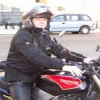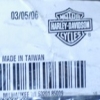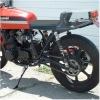Tuning carbs on a '76 400
- KitNYC
-
 Topic Author
Topic Author
- Offline
- User
-

Registered
- Posts: 123
- Thanks: 1
Tuning carbs on a '76 400
25 Apr 2006 10:39
Okay, Lou has offered me carb tuning notes from his friend's 400, & I've just discovered that main jets are available for these 30-year-old Keihins even if rebuild kits are not. The bike is a '76 KZ400 D3 with a Mac 2->1 & Uni pods. I'm *guessing* that this setup flows more air than stock, & I'm also guessing that that means I want to go up in jet size numbers...
Assuming I'm right about the above, does anyone have a good recommendation for where I should start? The Kawi parts list is no help; it lists jet sizes from 115-160 without saying what the bike shipped with.
Is it even vaguely worth doing this when the plugs read black & oily?
Thanks,
-Kit
Assuming I'm right about the above, does anyone have a good recommendation for where I should start? The Kawi parts list is no help; it lists jet sizes from 115-160 without saying what the bike shipped with.
Is it even vaguely worth doing this when the plugs read black & oily?
Thanks,
-Kit
Please Log in or Create an account to join the conversation.
- WharfRat
-

- Offline
- User
-

Registered
- Posts: 76
- Thanks: 0
Re: Tuning carbs on a '76 400
25 Apr 2006 14:38
Head on over to Ibsen's place
www.armbell.com/forum/index.php?mforum=kz400
I think the rebuild kits are available also.
www.armbell.com/forum/index.php?mforum=kz400
I think the rebuild kits are available also.
Kenosha,WI
1979 KZ 400B2
1980 KZ 750 E1
1979 KZ 650 B3
1979 KZ 400B2
1980 KZ 750 E1
1979 KZ 650 B3
Please Log in or Create an account to join the conversation.
- loudhvx
-

- Offline
- KZr Legend
-

Registered
- Posts: 10863
- Thanks: 1622
Re: Tuning carbs on a '76 400
25 Apr 2006 23:43
Here are the notes I made:
1976 KZ400 S2
Stock two into one exhaust.
The carbs have #35 pilot jets, #35 slow jets (after comparing to another kz400, it is apparent these have been drilled larger), #68 (could be 89?) starter jets, and #125 main jets (other models (dual exhaust) may have #130 main in stock setup) #90 pilot air jets, #40 main air jets drilled to #60, (after comparing to another kz400 (air jet marked #40 measured .4mm), it is apparent these have been drilled to #60, .6mm ).
AFAIK these are all stock numbers, but slow jet and main air jet were drilled.
We never ran this setup with the airbox since it was disassembled.
Jet description:
Starter jet: Large screw-in jet for starter (aka choke or enrichment) system only.
Slow jets: Long, skinny screw-in jet attached to a long, skinny emulsifier tube.
Pilot jet: Small, short, stubby screw-in type jet. It goes in after the slow jet.
Main jet: Large stubby press-in type jet with o-ring. It goes in after the main emulsifier tube.
Emulsifier tube: Long brass tube with pin holes along the wall of the tube. It's pressed in under the main jet.
Pilot air jet: Small stubby screw-in type jet that goes in the top of the carb.
Main air jet: Small stubby screw-in type jet that goes in the top of the carb.
note: the main air jet has a smaller orifice than the pilot air jet.
From the top, the main air jet and pilot air jet can be swapped accidently.
The main air jet goes between the pilot air jet and the screw that holds the plate.
Typically, the numbers represent the diameter of the orifice in hundredths of millimeters.
Some random notes:
Air jets get air from the round port on the Air horn.
Big oval port on the air horn gives atmospheric pressure to the bottom of the slide piston.
Starter system plunger also applies manifold vacuum to bottom of slide (by unblocking the passage) to keep it down during cold starts.
The starter plunger also unblocks the enrichment port to allow more fuel into the manifold passage.
Fuel path for Main circuit:
Tank-float bowl-main jet-needle jet/emulsifier tube-carb bore
Fuel path for Pilot circuit:
Tank-float bowl-main jet- pilot jet-slow jet- pilot passage- pilot screw- pilot port- carb bore
If throttle is open, fuel bypasses the pilot screw and pilot port and goes through a bypass tube straight to the carb bore.
Main air jet meters air into the main emulsifier tube to start mixing with fuel.
Pilot air jet meters air into the pilot passage containing the slow jet's emulsifier tube to start mixing with fuel.
We installed Uni pod filters (properly oiled). The bike fuel-fouled the plugs in just a couple days (engine would not start). At idle, the mixture screws needed to be in all the way. Off idle it was still too rich. This was not expected, but was probably due to the slow jets being drilled out. We expected it to be lean.
Because someone drilled the slow jets, they were deemed unuseable. We scrounged some very similar #35 slow jets from a Honda CL350.
Each of these trials were tested on the road and on an exhaust gas analyzer using the rear brake as a load.
Tried using:
Uni Pods
#35? slow jets from a 1970 Honda CL350. (the number looks like 35. The emulsion holes are bigger.)
#35 pilot jets
#68 (89?) starter jets
#100 main jet from 1970 Honda CL350.
#90 pilot air jets
#40 main air jets (drilled to #60, .6mm)
Set mixture screws.
This setup was too lean off idle and especially at high RPM under load.
Tried using:
Uni Pods
#35? slow jets from a 1970 Honda CL350. (the number looks like 35. The emulsion holes are bigger.)
#35 pilot jets
#68 (89?) starter jets
#125 main jet
#90 pilot air jets
#40 main air jets (drilled to #60, .6mm)
Set mixture screws.
This runs slightly rich at intermediate throttle, but ok. Highway runs show up as lean on the spark plug.
Now using:
Uni Pods
#35? slow jets from a 1970 Honda CL350. (the number looks like 35. The emulsion holes are bigger.)
#35 pilot jets
#68 (89?) starter jets
#132 main jet (Drilled out the 100 Honda jet to 132)
#90 pilot air jets
#40 main air jets (drilled to #60, .6mm)
Set mixture screws.
This has been running for a year and half. Starts easy even in cold weather. Idles smooth. Runs smooth all the way up to red-line. Plugs have not fouled.
Plugs show a dark grey, but work fine. After a year and a half of running and outdoor exposure etc. The plugs were starting to get darker. The filters were cleaned and oiled and the bike continues to run fine with plugs back to normal color.
Conclusion: It seems the final result is that the only real difference from stock, by using Uni Pod filters, was the main air jet is drilled to #60 from #40, and the main jet is a #132 instead of #125. It could not be determined if the #60 is desirable over the #40 since we did not have an unmolested #40 for comparison.
This is for a 1976 KZ400 S2 which came with a 2 into 1 exhaust and smaller main jets than the dual exhaust model.
A 1976 KZ 400 D model may need #135 or #137 main jets to account for more flow in the dual exhaust.
Post edited by: loudhvx, at: 2006/04/26 02:50
1976 KZ400 S2
Stock two into one exhaust.
The carbs have #35 pilot jets, #35 slow jets (after comparing to another kz400, it is apparent these have been drilled larger), #68 (could be 89?) starter jets, and #125 main jets (other models (dual exhaust) may have #130 main in stock setup) #90 pilot air jets, #40 main air jets drilled to #60, (after comparing to another kz400 (air jet marked #40 measured .4mm), it is apparent these have been drilled to #60, .6mm ).
AFAIK these are all stock numbers, but slow jet and main air jet were drilled.
We never ran this setup with the airbox since it was disassembled.
Jet description:
Starter jet: Large screw-in jet for starter (aka choke or enrichment) system only.
Slow jets: Long, skinny screw-in jet attached to a long, skinny emulsifier tube.
Pilot jet: Small, short, stubby screw-in type jet. It goes in after the slow jet.
Main jet: Large stubby press-in type jet with o-ring. It goes in after the main emulsifier tube.
Emulsifier tube: Long brass tube with pin holes along the wall of the tube. It's pressed in under the main jet.
Pilot air jet: Small stubby screw-in type jet that goes in the top of the carb.
Main air jet: Small stubby screw-in type jet that goes in the top of the carb.
note: the main air jet has a smaller orifice than the pilot air jet.
From the top, the main air jet and pilot air jet can be swapped accidently.
The main air jet goes between the pilot air jet and the screw that holds the plate.
Typically, the numbers represent the diameter of the orifice in hundredths of millimeters.
Some random notes:
Air jets get air from the round port on the Air horn.
Big oval port on the air horn gives atmospheric pressure to the bottom of the slide piston.
Starter system plunger also applies manifold vacuum to bottom of slide (by unblocking the passage) to keep it down during cold starts.
The starter plunger also unblocks the enrichment port to allow more fuel into the manifold passage.
Fuel path for Main circuit:
Tank-float bowl-main jet-needle jet/emulsifier tube-carb bore
Fuel path for Pilot circuit:
Tank-float bowl-main jet- pilot jet-slow jet- pilot passage- pilot screw- pilot port- carb bore
If throttle is open, fuel bypasses the pilot screw and pilot port and goes through a bypass tube straight to the carb bore.
Main air jet meters air into the main emulsifier tube to start mixing with fuel.
Pilot air jet meters air into the pilot passage containing the slow jet's emulsifier tube to start mixing with fuel.
We installed Uni pod filters (properly oiled). The bike fuel-fouled the plugs in just a couple days (engine would not start). At idle, the mixture screws needed to be in all the way. Off idle it was still too rich. This was not expected, but was probably due to the slow jets being drilled out. We expected it to be lean.
Because someone drilled the slow jets, they were deemed unuseable. We scrounged some very similar #35 slow jets from a Honda CL350.
Each of these trials were tested on the road and on an exhaust gas analyzer using the rear brake as a load.
Tried using:
Uni Pods
#35? slow jets from a 1970 Honda CL350. (the number looks like 35. The emulsion holes are bigger.)
#35 pilot jets
#68 (89?) starter jets
#100 main jet from 1970 Honda CL350.
#90 pilot air jets
#40 main air jets (drilled to #60, .6mm)
Set mixture screws.
This setup was too lean off idle and especially at high RPM under load.
Tried using:
Uni Pods
#35? slow jets from a 1970 Honda CL350. (the number looks like 35. The emulsion holes are bigger.)
#35 pilot jets
#68 (89?) starter jets
#125 main jet
#90 pilot air jets
#40 main air jets (drilled to #60, .6mm)
Set mixture screws.
This runs slightly rich at intermediate throttle, but ok. Highway runs show up as lean on the spark plug.
Now using:
Uni Pods
#35? slow jets from a 1970 Honda CL350. (the number looks like 35. The emulsion holes are bigger.)
#35 pilot jets
#68 (89?) starter jets
#132 main jet (Drilled out the 100 Honda jet to 132)
#90 pilot air jets
#40 main air jets (drilled to #60, .6mm)
Set mixture screws.
This has been running for a year and half. Starts easy even in cold weather. Idles smooth. Runs smooth all the way up to red-line. Plugs have not fouled.
Plugs show a dark grey, but work fine. After a year and a half of running and outdoor exposure etc. The plugs were starting to get darker. The filters were cleaned and oiled and the bike continues to run fine with plugs back to normal color.
Conclusion: It seems the final result is that the only real difference from stock, by using Uni Pod filters, was the main air jet is drilled to #60 from #40, and the main jet is a #132 instead of #125. It could not be determined if the #60 is desirable over the #40 since we did not have an unmolested #40 for comparison.
This is for a 1976 KZ400 S2 which came with a 2 into 1 exhaust and smaller main jets than the dual exhaust model.
A 1976 KZ 400 D model may need #135 or #137 main jets to account for more flow in the dual exhaust.
Post edited by: loudhvx, at: 2006/04/26 02:50
1981 KZ550 D1 gpz.
Kz550 valve train warning.
Other links.
Kz550 valve train warning.
Other links.
Please Log in or Create an account to join the conversation.
Moderators: Street Fighter LTD
